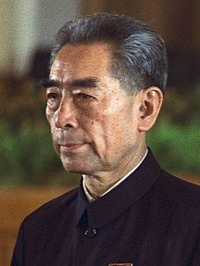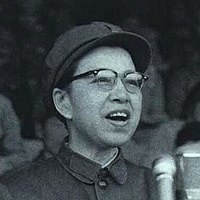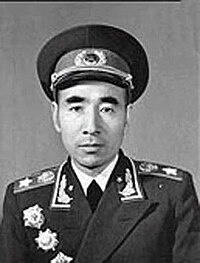-
Use Cases
-
Resources
-
Pricing
Chinese Cultural Revolution Timeline
(1966 - 1976)Social and Cultural Changes
Mao's Little Red Book becomes a symbol of the revolution
1966
% complete
Mao's Little Red Book, also known as Quotations from Chairman Mao Tse-tung, was a book of selected quotations from the speeches and writings of Chinese Communist leader Mao Zedong. It was first published in 1964 and became a key propaganda tool during the Cultural Revolution. The book was widely distributed and studied, and carrying it became a symbol of loyalty to Mao and the revolution.
Image source: Quotations from Chairman Mao Tse-tung

Cultural Revolution spreading to universities and schools
1966 - 1968
% complete
During the Cultural Revolution from 1966 to 1968, the movement spread to universities and schools throughout China. Red Guard groups were formed within these institutions to enforce the revolutionary ideology and criticize teachers and administrators who were seen as representatives of the old system. Schools and universities were shut down for extended periods of time as students focused on political meetings, studying Mao's writings, and engaging in acts of class struggle. This period led to a disruption of traditional education and a transformation of the Chinese education system.
Destruction of the "Four Olds" (Old Customs, Culture, Habits, and Ideas)
August 1966
% complete
The Destruction of the 'Four Olds' refers to the campaign launched by Mao Zedong during the Chinese Cultural Revolution in August 1966. The goal of this campaign was to eliminate the remnants of traditional Chinese culture and promote revolutionary ideology. The 'Four Olds' referred to old customs, old culture, old habits, and old ideas. Red Guard groups were formed to enforce the campaign and they attacked and destroyed cultural artifacts, temples, libraries, and historical sites. This campaign led to the loss of many cultural treasures and had a lasting impact on Chinese society.
Image source: Four Olds

"Up to the Mountains and Down to the Countryside" movement begins
1968
% complete
The "Up to the Mountains and Down to the Countryside" movement was a government policy in China that began in 1968 during the Cultural Revolution. Its aim was to send urban youth, particularly students, to rural areas to experience agricultural labor and learn from the peasants. The movement was intended to break down social hierarchies and create a more egalitarian society. However, it often resulted in hardship, as many of the youth were ill-prepared for the physical demands of rural life and faced difficulties in adapting to a new environment. The movement gradually declined in the early 1970s as the Cultural Revolution came to an end.
"Down to the Countryside" movement intensifies
1969 - 1976
% complete
The 'Down to the Countryside' movement intensifies during this period of time in China. It started in 1969 and continued until 1976. During this movement, millions of urban youth were sent to rural areas to learn from peasants and experience rural life firsthand. The goal was to promote ideological purity and reconnect urban youth with the working class. Many of the young people faced harsh living conditions, manual labor, and limited access to education and healthcare. This movement had a significant impact on Chinese society and the lives of those who participated.
Publication of "To Live" by Yu Hua, reflecting on the Cultural Revolution
1993
% complete
Publication of "To Live" by Yu Hua, reflecting on the Cultural Revolution (1993).
Political Movements
Mao Zedong launches the Cultural Revolution
May 16, 1966
% complete
Mao Zedong launches the Cultural Revolution on May 16, 1966, calling for a purge of 'impure' elements within the Communist Party and a return to revolutionary Maoist ideology. This campaign would lead to widespread social and political upheaval in China over the next decade.
Establishment of Revolutionary Committees
January 1967
% complete
The Establishment of Revolutionary Committees marked the formalization of the power struggle and factional infighting within the Chinese Communist Party during the Cultural Revolution. In January 1967, Mao Zedong called for the formation of Revolutionary Committees to replace the existing local governments and party authorities. These committees were intended to be a grassroots organization that would enforce Mao's revolutionary ideology and promote class struggle. However, instead of uniting the people, the Revolutionary Committees became another source of conflict and chaos, as different factions competed for power and engaged in violent struggles. The Establishment of Revolutionary Committees further deepened the political divisions and led to widespread social unrest and oppression.
Formation of the Shanghai Commune
January 1967
% complete
Formation of the Shanghai Commune (January 1967): The Shanghai Commune was established during the peak of the Cultural Revolution in China. It was a radical political movement that aimed to create a classless society and promote communist ideals. The commune was formed through mass mobilization and active participation of the people, with workers, students, and local residents coming together to take control of the city's administration. The Shanghai Commune implemented policies centered around revolutionary fervor, such as radical land reforms, communal living, and the suppression of counter-revolutionary elements. However, the commune only lasted for a brief period of time before being dissolved by the Chinese government in 1968. Despite its short existence, the Shanghai Commune symbolized the radical aspirations and grassroots activism of the Cultural Revolution.
Image source: Shanghai People's Commune

Purging of "Capitalist roaders" from the Communist Party
July 1967
% complete
The purging of 'Capitalist roaders' from the Communist Party was a political campaign launched by Mao Zedong during the Chinese Cultural Revolution. It aimed to remove party members who were seen as deviating from socialist principles and pursuing a capitalist path. The campaign began in July 1967 and lasted until Mao's death in 1976. During this period, thousands of party members and officials were purged, including prominent leaders such as Liu Shaoqi and Deng Xiaoping. The purges involved public criticism, forced labor, and sometimes violence, leading to widespread chaos and instability in Chinese society.
Zhou Enlai's death and the end of the radical phase
January 8, 1976
% complete
Zhou Enlai, the premier of China, dies on January 8, 1976. His death marks the end of the radical phase of the Cultural Revolution.
Image source: Zhou Enlai

"Gang of Four" arrested and blamed for excesses of the Cultural Revolution
October 1976
% complete
The Gang of Four was a group of four Chinese Communist Party officials who were highly influential during the Cultural Revolution. They were made up of Jiang Qing, Mao Zedong's wife, and three other prominent party members. They were known for their radical policies and aggressive tactics during the revolution, which led to widespread chaos and violence. After Mao's death in 1976, the new leadership arrested the Gang of Four and blamed them for the excesses and mistakes of the Cultural Revolution. They were tried and convicted of a range of charges, including conspiracy to overthrow the government, and were sentenced to prison.
Image source: Gang of Four

Rehabilitation of victims of the Cultural Revolution
1978 - Present
% complete
Rehabilitation of victims of the Cultural Revolution (1978 - Present) - After the end of the Cultural Revolution in 1976, the Chinese government initiated a process of rehabilitating the victims of the revolution. This process involved acknowledging the injustices and suffering that occurred during the Cultural Revolution, offering compensation and support to those affected, and pursuing legal actions against the perpetrators. The rehabilitation of victims has been an ongoing process, with efforts being made to provide justice and restore the reputation and well-being of those who suffered.
Opening up of China's economy and reforms under Deng Xiaoping
1978 - Present
% complete
The Opening up of China's economy and reforms under Deng Xiaoping occurred in 1978. Deng Xiaoping introduced a series of economic and political reforms that aimed to modernize China and improve the standard of living. These reforms included the relaxation of state control over the economy, the encouragement of foreign investment, the establishment of Special Economic Zones, and the promotion of market-oriented policies. As a result, China experienced significant economic growth and became a major player in the global economy.
Official condemnation of the Cultural Revolution by the Chinese government
1981
% complete
Official condemnation of the Cultural Revolution by the Chinese government (1981).
Key Policies and Campaigns
"Bombard the Headquarters" campaign begins
August 1966
% complete
The "Bombard the Headquarters" campaign was launched on August 1966 by Chairman Mao Zedong during the Chinese Cultural Revolution. It marked the beginning of a mass movement within the Communist Party of China that aimed to challenge and remove those considered to be revisionists and counter-revolutionaries within the party leadership. The campaign led to widespread political persecution, violence, and chaos, as Red Guard factions formed across the country and targeted individuals and institutions associated with the old order. The campaign continued until Mao called for its end in 1968.
"May 7th Cadre Schools" established for reeducation
1968
% complete
May 7th Cadre Schools were established in May 1968 as part of the Chinese Cultural Revolution. These schools were set up to reeducate and reform cadres who were believed to have strayed from the principles of the revolution. The schools aimed to train and transform these cadres through intensive ideological education and physical labor. The duration of the reeducation varied depending on the individual and their level of commitment to the revolution. The May 7th Cadre Schools played a significant role in shaping the political landscape of China during this period.
Red Guard Activities
Formation of the Red Guards
August 18, 1966
% complete
Formation of the Red Guards: On August 18, 1966, chairman of the Chinese Communist Party, Mao Zedong, encouraged Chinese youth to form paramilitary groups known as the Red Guards. These groups were mobilized to protect the Chinese Communist Party and carry out the goals of the Cultural Revolution.
Image source: Red Guards

Mao's Red Guards attack foreign embassies and diplomats
August 1967
% complete
Mao's Red Guards attack foreign embassies and diplomats on August 1967. During the attack, the Red Guards vandalized the embassies and physically assaulted diplomats from various countries.
Major Figures and Leadership
Lin Biao becomes Mao's designated successor
1969
% complete
Lin Biao becomes Mao's designated successor in 1969. He is named as Mao's successor during the Ninth Congress of the Chinese Communist Party.
Image source: Lin Biao

Death of Lin Biao under mysterious circumstances
September 13, 1971
% complete
On September 13, 1971, Lin Biao, the Vice Chairman of the Communist Party of China and Minister of Defense, died under mysterious circumstances. It is believed that Lin Biao attempted to stage a coup against Chairman Mao Zedong, but the plan failed. Lin Biao and his family attempted to flee to the Soviet Union, but their plane crashed in Mongolia, resulting in their deaths. The exact circumstances surrounding the crash and Lin Biao's motivations remain controversial and debated by historians.
Mao Zedong's death
September 9, 1976
% complete
Mao Zedong, the founding father of the People's Republic of China, dies at the age of 82. His death marks the end of Mao's era and the beginning of a new phase in Chinese history. During his leadership, Mao implemented various policies and campaigns that had a profound impact on China and its people. Mao's death leads to a power struggle within the Communist Party and eventually paves the way for Deng Xiaoping's economic reforms.
Deng Xiaoping emerges as the new leader
1978
% complete
Key Facts
- The Cultural Revolution was launched by Chairman Mao Zedong in order to eliminate his political rivals and consolidate his power.
- The Red Guards, groups of young and zealous students, were mobilized to enforce Maoist ideology and suppress dissent.
- Intellectuals, teachers, artists, and those associated with the bourgeoisie were targeted and subjected to persecution, violence, and public humiliation.
- Traditional Chinese culture and customs, including ancient artifacts, temples, and historical sites, were destroyed as part of the revolution's efforts to establish a new socialist society.
- The Cultural Revolution ended with Chairman Mao’s death in 1976, with the government subsequently denouncing the movement and its excesses.
Source
This Chinese Cultural Revolution timeline was generated with the help of AI using information found on the internet.
We strive to make these timelines as accurate as possible, but occasionally inaccurates slip in. If you notice anything amiss, let us know at [email protected] and we'll correct it for future visitors.
Create a timeline like this one for free
Preceden lets you create stunning timelines using AI or manually.
Customize your timeline with one of our low-cost paid plans
Export your timeline, add your own events, edit or remove AI-generated events, and much more
Free
$
0
free forever
No credit card required.
Basic
$
10
/month
billed annually
Cancel anytime.
Pro
$
16
/month
billed annually
Cancel anytime.
Common Questions
Can I cancel anytime?
Yes. You can cancel your subscription from your account page at anytime which will ensure you are not charged again. If you cancel you can still access your subscription for the full time period you paid for.
Will you send an annual renewal reminder?
Yes, we will email you a reminder prior to the annual renewal and will also email you a receipt.
Do you offer refunds?
Yes. You can email us within 15 days of any payment and we will issue you a full refund.
What if I have more questions?
Check out our pricing docs or send us an email anytime: [email protected].
